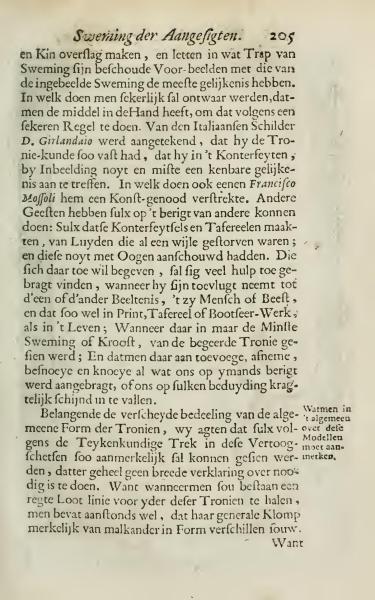Tilting of Faces
and Chin adjustments, and observe in what degree of Swaying the studied Examples have the greatest similarity with the imagined Swaying. In doing this, one will certainly discover that one has the means in Hand to do this according to a certain Rule. It was noted of the Italian Painter D. Ghirlandaio that he mastered the art of facial likenesses so completely that he never failed to achieve a recognizable resemblance through imagination when creating portraits. This was also reinforced by a fellow artist Francisco Mssolij. Other talents could also perform such tasks based on reports from others: Such that they created portraits and tableaux of People who had been deceased for a while and whom they had never seen with their own Eyes. Those who wish to do so will find much assistance, when they resort to one or another representation, whether Human or Animal, both as Print, Tableaux, or Stage Craft, as in Life; Whenever even the slightest Swaying or Line of the desired Face was seen; And that one adds, removes, prunes and tweaks all that is brought to us by someone's report, or seems strongly suggested by such indications.
Concerning the various distributions of the common Form of Faces, we consider that according to the Artistic Line in these Representational sketches it can be significantly shown that there is no need for a broad explanation. Because when one draws a straight vertical line for each of these Faces, it is immediately evident that their overall Mass clearly differs from one another in Form.
Because
Translation Notes
- "Sweining der Aangesigten" is translated as "Tilting of Faces."
- "Konterfeyten" means "creating portraits," referring to the art of making likenesses.
- "Tronie-kunde" is the study or skill of facial likenesses.
The text discusses the art of achieving realistic likenesses in portraits by following specific principles. It refers to artists like D. Ghirlandaio, known for his skill in creating accurate facial resemblances from imagination, and other artists who achieved similar tasks through reports of others. It also addresses the general form of faces and the differences in the overall structures of facial drawings.
